Employee Engagement: Harnessing the power of human potential in your organization
INTRODUCTION
Of all the aspects of an organization that can define its success, perhaps the most influential – and most unpredictable – is the employees who do the work. Employees determine how much work gets done and how well that work is accomplished. They can be your organization’s greatest cheerleaders or most fervent critics. And despite leadership’s best efforts to shape the culture with perks and policies, employees are the ones truly setting the tone.
Given the nature of these human resources, it may seem impossible to measure the impact of the employee. Not so. In measuring employee engagement, you can predict future success and make adjustments internally to improve business outcomes.
Once you have reviewed what employee engagement is, the impact it can have on your organizational success, and how to measure and increase employee engagement, you’ll be well on your way to charting a course for organizational success – one employee at a time.
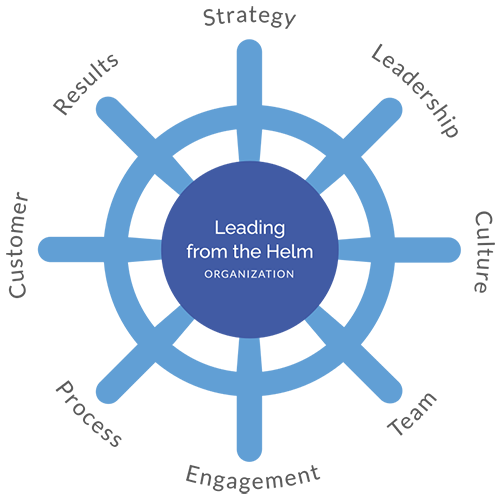
ENGAGEMENT AS THE FOUNDATION OF THE ORGANIZATIONAL HELM
Engagement is core to Sicora Consulting’s proprietary Leading from the Helm model for organization development and effectiveness. The Helm is proven to take a balanced, holistic approach to maximizing individual potential and organizational success.
Engagement is the foundation of the Helm, working with Strategy, Leadership, Culture, Team, Process, Customer, and Results to steer your organization in the right direction.
WHAT IS EMPLOYEE ENGAGEMENT?

First, let’s define employee engagement. The concept of employee engagement has evolved over time since it was first established as an organizational construct in a 1990 article of the Academy of Management Journal. Today, employee engagement relates to the connectiveness and commitment an employee (or any staff member) has toward their work, their team, and their organization’s shared purpose. This is demonstrated by the way they feel, think, and act in alignment with that purpose to produce an outcome that helps to reach and exceed the intended goals. As such, it is a pivotal component of organizational effectiveness.
We’ve found that the most engaged employees are loyal to your organization and feel a strong sense of association. They are the ones you can count on to champion the organization externally and to give their best efforts internally. But engagement doesn’t just happen. Beyond the manager, it needs to be nurtured by the organization, the team, and even the individual employee.
Ultimately, cultivating employee engagement involves promoting an environment that allows employees to:
- Deliver their best work daily
- Contribute to the short- and long-term goals of the organization with passion and purpose
- Feel consistently fulfilled in their work
- Fully trust and care for one another on both a personal and professional level
At its core, employee engagement provides your workforce with a sense of belonging and motivation to contribute to the greater success of the group.
Examples of Employee Engagement
Seeing employee engagement in action can be tricky. It’s tied closely to organizational culture in that it’s influenced by culture and reflects it. A healthy organizational culture based in trust can foster higher employee engagement.
Whereas culture at its core refers to how things get done, employee engagement might determine how well things get done, or how enthusiastic employees feel about doing those things.
Let’s look at a concrete example.
It may be your organization’s culture that decisions are made largely by team consensus, typically in a meeting. An actively engaged employee would be one who consistently contributes to the discussions within those meetings in a constructive way. A cautiously engaged employee may be hesitant to bring their whole self to work or to share opinions. They may be a high performer in their individual contributor or manager role, yet they might shy away from expressing views that could help a project but may sound contrary or negative to others. An employee who is not engaged might miss meetings or spend them thinking about other things or otherwise disconnecting from the conversation.
Now that we have an idea of what employee engagement might look like at its various levels of engagement, let’s drill down and define these types of employee engagement:

Actively Engaged
Actively engaged employees who are aligned with the organization’s mission and feel a sense of shared purpose. They tend to be high performers who are passionate and take ownership of their work. Terms often used to describe actively engaged employees: high performance, raising the bar, passionate, aligned, shared purpose, ownership, lead by example, highly innovative, advocate.

Cautiously Engaged
Cautiously engaged employees may be holding back a bit. They may be uncertain of the foundation of engagement that has been created. They are relatively committed to their work and/or workplace, put in a good effort, and tend to be average performers. Terms often used to describe cautiously engaged employees: average performance, good effort, moderate, steady contributor.
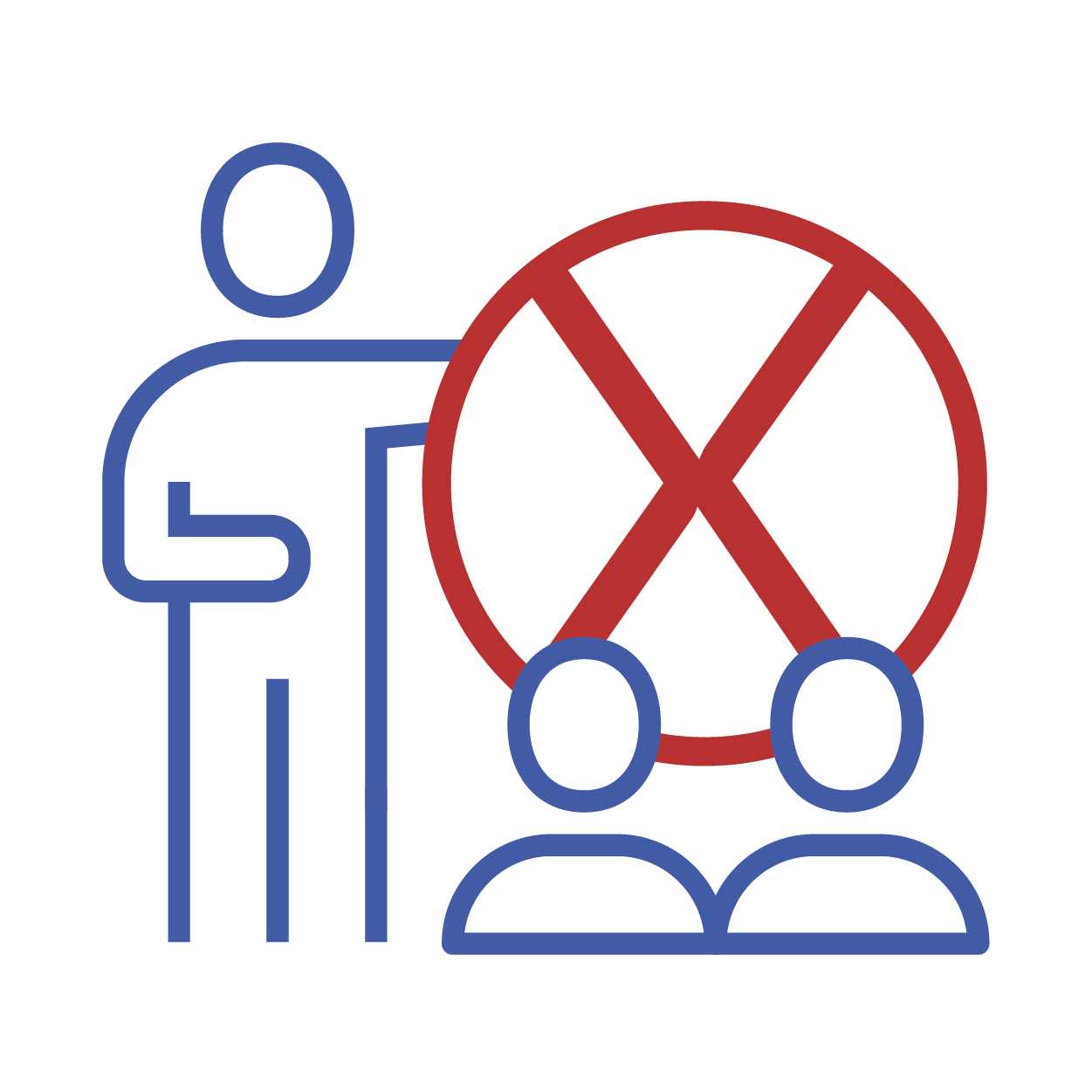
Not Engaged
Employees who are not engaged are unhappy and disconnected. They may be lower performers and impact others’ performance in a negative way. Terms often used to describe employees who are not engaged: lower performer, lowering the bar, unhappy, disconnected, impact others’ performance, affect trust, stuck.
A note about actively disengaged employees:
We avoid the term “actively disengaged” when referring to someone who is not engaged, as someone who is “actively disengaged” would be toxically infusing distrust within the work environment and undermining team and organizational goals. Someone who is not engaged may feel stuck or be caught in a bad moment, or your organization might not be the right fit for them. A not engaged employee is not a hopeless case and is not necessarily going out of their way to harm the organization.
Employee Engagement at Every Level
While employee engagement can have a significant impact on the organizational level, it’s often even more profoundly influential at the team and individual levels. It’s important to look at employee engagement at every level to paint an accurate picture of employee engagement in your organization:
INDIVIDUAL ENGAGEMENT

How we see our own personal engagement with the work we do each day.
TEAM ENGAGEMENT

How we see the engagement of team members impacting our level of engagement as we go about working with each other every day.
ORGANIZATIONAL ENGAGEMENT

How we see the organization providing us the support we need and development opportunities we want and how that impacts our own engagement.
Employee engagement is a complex matter, but it’s worth addressing with your employees, within your teams, and within your organization to gain a holistic view of its impact.
IMPACT OF EMPLOYEE ENGAGEMENT
Why is employee engagement important? It’s a leading performance indicator for an organization, meaning it’s a forward-looking metric that can help determine future success (or lack thereof) for your organization. Higher engagement drives higher work performance, which drives higher client engagement, which drives greater outcomes.
Leading indicators allow you and your staff to take action and ownership. In contrast, a lagging indicator looks at the past to determine the current health of your organization. Lagging indicators — sometimes referred to as “experiential indicators” — are measured in terms of a past experience. For instance, programs like the Net Promoter Score (NPS) or Best Places to Work surveys measure how someone experienced the past. You can use lagging indicators as a benchmark for comparison, but you can’t directly act on them like you can with leading indicators.
Regularly assessing your organization’s employee engagement metrics can inform your strategy and identify opportunities for improvement or additional attention. As a result, you’ll find yourself with an employee-led culture of engagement, and lagging indicators (NPS, etc.) will likely improve, too!
As part of the Balanced Scorecard – a strategic planning and management system that aligns business activities to the vision and strategy of the organization – employee engagement drives work performance and process, which drives customer engagement, ultimately driving overall results. In short, if you invest in the concept of employee engagement, you’re going to get a higher return on overall organizational performance.

More immediately, some of the benefits of employee engagement include:
• Increased employee productivity and loyalty to the team
• Increased employee motivation to produce better work
• Activation of your employees’ passions
• Increased employee commitment to the success of the organization
• Strengthened emotional connection between team members, leadership,
and the organization
• More innovative solutions and approaches to work challenges
• Improved customer delight and client loyalty
• Positive impact on other measures of organizational effectiveness (as
presented in the Leading from the Helm model)
Not only does high employee engagement have far-reaching benefits, but less engaged employees can actually pose a threat to your business and its future. When employees are misaligned with the goals of the organization, both the quantity and quality of work take a hit. If employees do not feel committed to the work they’re doing, they may be more prone to misusing their time or may find themselves increasingly unhappy at work.
Disengagement is infectious and can quickly spread. Disengaged employees are more likely to speak negatively about your brand, either while they’re still a part of the organization or after they’ve moved on. Other employees might need to pull more than their own weight to accomplish the work that needs to be done. This can contribute to an increasingly toxic work environment and decrease in trust, which can foster more disengagement.
So where can you focus to boost positive employee engagement?
DRIVERS OF EMPLOYEE ENGAGEMENT: THE 8 FACTORS OF ENGAGEMENT MODEL
Knowing you need to take action and knowing what action to take can be two different things.
EMPLOYEE ENGAGEMENT: HARNESSING THE POWER OF HUMAN POTENTIAL IN YOUR ORGANIZATION, Sicora Consulting
That’s one reason Sicora Consulting developed the 8 Factors of Engagement. In our experience with other employee engagement models and our familiarity with the 4 Colors of Insights and the 8 Styles of Personality, we realized employee engagement was a holistic system, where the contributing factors influenced each other. Improving one factor, we hypothesized, would improve others.
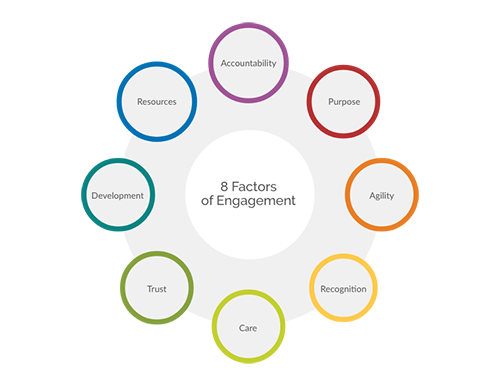 The idea was to come up with a model that was holistic, completely balanced, consisted of leading indicators, and could be used on a real-time basis. We wanted to offer organizations actionable insights that led to real solutions. The model also mapped directly to the 4 Colors of Insights and 8 Styles of Personality. Knowing we each have all four colors and eight styles of personality within us, we aimed to develop an engagement model that includes both to ensure it was both holistic and balanced.
The idea was to come up with a model that was holistic, completely balanced, consisted of leading indicators, and could be used on a real-time basis. We wanted to offer organizations actionable insights that led to real solutions. The model also mapped directly to the 4 Colors of Insights and 8 Styles of Personality. Knowing we each have all four colors and eight styles of personality within us, we aimed to develop an engagement model that includes both to ensure it was both holistic and balanced.
After an extensive literary review that included leading trust research, and reflection on our own decades of experience in organization development, we determined which factors contribute directly to employee engagement and wrote our survey to account for engagement at all three levels: individual, team, and organization. This triangulation ensures nothing is overlooked. For instance, if an employee feels cared for within their team but feels the organization falls flat, the data from the 8 Factors of Engagement surveys reflects that, allowing the organization to act accordingly.
Additionally, the model’s primary focus on leading indicators and pulse survey cadence – checking in with employees each quarter in 3-minute surveys rather than once a year – enables organizational agility at a time when it is arguably more critical than ever. Organizations are facing more rapid and disruptive change, and they need to be innovative and more agile with how they listen to and act on the voice of the employee. The 8 Factors of Engagement model enables organizations to immediately execute on strategy, leadership development, and culture-building.
Example Timeline for Annual Engagement Program
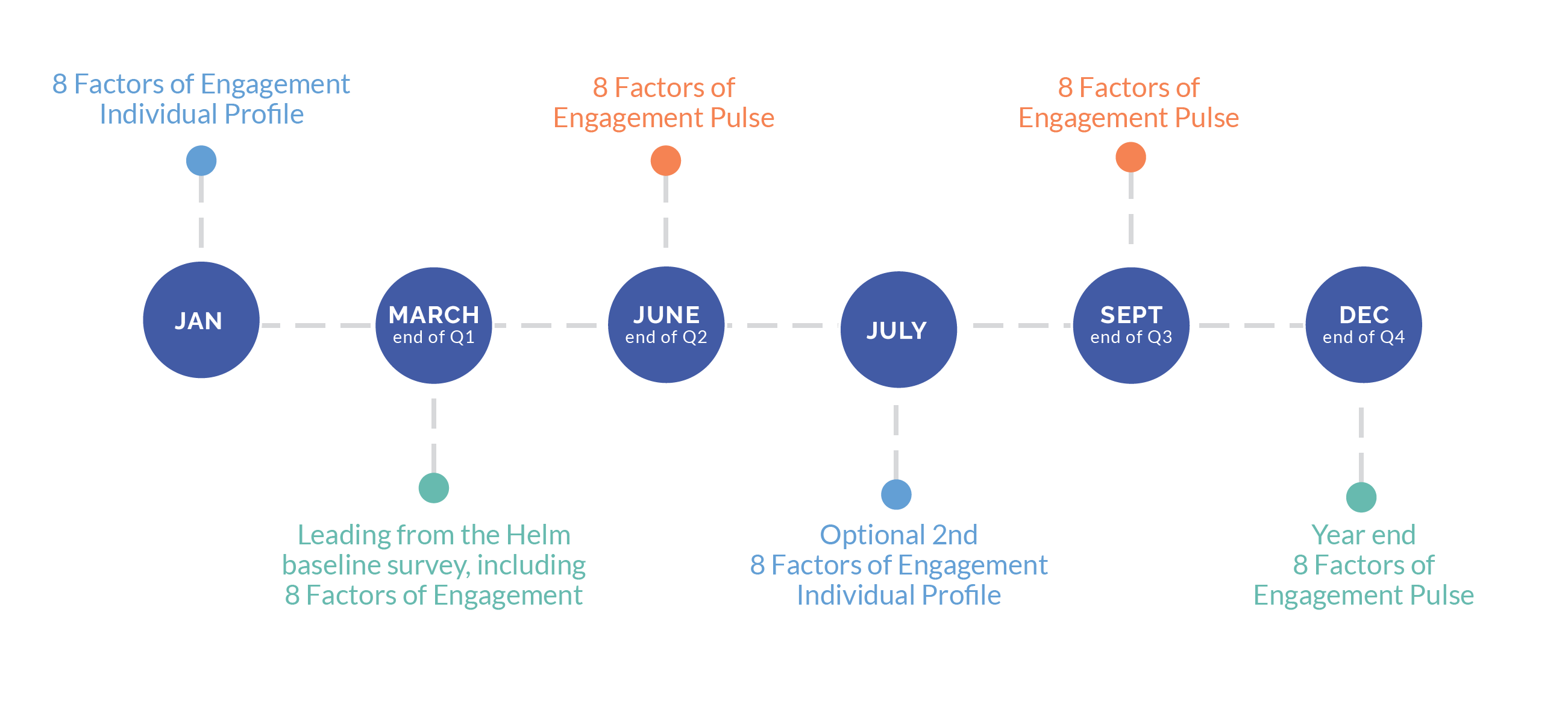
THE 8 FACTORS OF ENGAGEMENT
The 8 Factors of Engagement is a science-based model that promotes trust, shared purpose, and improved performance among your workforce. Let’s dive into each of the eight factors to see how each one can contribute to fostering an employee-led culture of continuous engagement within your organization.
While the model itself is balanced and maps to the circular 4 Colors of Insights and 8 Styles of Personality models, there is a research-based priority to approaching the factors, building on each other to form a hierarchy for action planning.

PURPOSE
The first and most significant factor – with increasing relevance – is purpose. Purpose in the context of organizational effectiveness is the alignment of passion and talent toward accomplishing a shared mission. When properly cultivated, purpose aligns your team members’ individual pursuits with those of the organization to drive increased retention, customer satisfaction, and profitability. Increased employee turnover, like that seen with the Great Resignation, is a lagging indicator. Employees aren’t quitting because everyone else is doing it; they’re quitting in part because they don’t feel a strong sense of purpose in their work, and may not have for quite some time. Organizations with the benefit of a leading indicator – like employees’ sense of purpose in their work – may be able to take proactive steps to stem turnover.
Nurturing purpose starts with placing employees in the right roles and then playing to their strengths and passions. Employees who don’t understand why they’re here or who don’t feel connected to their work on a deeper level likely won’t reach their maximum potential within your organization. Alignment between individual goals and the goals of the team or organization is key.
Collectively, we can get more accomplished than just one person can, and it is more engaging – and downright infectious – to work on a team that’s looking toward the horizon together.
Reflecting on Purpose
- How can we ensure employees are doing work they’re passionate about and that aligns with organizational goals?
- How do we as an organization empower employees to take command with purpose and work toward a shared vision, using their unique talents and passions?
ACCOUNTABILITY
Accountability refers to setting and maintaining high quality standards of performance and supporting and coaching employees to achieve desired results. Employees need to understand what their job is and how it aligns with the bigger picture – the shared purpose the whole team is working toward.
Chart a clear course for success. Goals and expectations should be clearly defined for both individual roles and each project to set employees up for success. Employees should understand what it means to meet and exceed expectations and understand how they will be assessed. They should also trust that their teammates are being held accountable to their work, as so much of an individual’s performance is impacted by the work of others. If there is a bottleneck or missed deadline elsewhere in the system, an employee shouldn’t worry that they’ll take all the blame for not being able to produce their own share of the work.
Accountability can take the form of SMART (specific, measurable, aligned, raising the bar, time-based) goals, documented processes and expectations, and regular, informal check-ins on progress to identify and remove roadblocks thereby enhancing trust, confidence, and by extension, engagement. This goes beyond formal annual reviews. These quarterly talks, while the responsibility of managers, can be initiated by employees. Give employees regular feedback, both good and bad. Don’t wait for a work anniversary to let them know if they’ve been missing the mark.
Most importantly, ensure employees have clarity around what they’re doing and what the team is doing, and give them what they require to do their part.
Reflecting on Accountability
- How can we ensure employees clearly understand what is expected of them in their work and their contributions to the team?
- How are staff members held accountable for the quality of their work?
RESOURCES
Resources are the materials, people, and information needed to get work done. For employees to do their jobs to the best of their abilities and deliver on their contributions to purpose, they need access to the right resources.
Just as you wouldn’t send a sailor out to sea without a map and compass, you shouldn’t send your employees to work without everything they need to get the job done – and get it done well.
Whether this includes specific software, training and onboarding information, time, talent, or simply candid access to the right people, no one should be expected to produce their highest quality work if they don’t have the tools to do so.
Access to resources has become increasingly important in the shift to hybrid work environments. As hybrid becomes more prevalent and even permanent in many organizations, it’s important to consider the impact on the resources employees need to continue to engage in their work.
Most importantly, you need to trust employees with the necessary resources and allow them to request what they need.
Whether this includes specific software, training and onboarding information, time, talent, or simply candid access to the right people, no one should be expected to produce their highest quality work if they don’t have the tools to do so.
Access to resources has become increasingly important in the shift to hybrid work environments. As hybrid becomes more prevalent and even permanent in many organizations, it’s important to consider the impact on the resources employees need to continue to engage in their work.
Most importantly, you need to trust employees with the necessary resources and allow them to request what they need.
Reflecting on Resources
- Which resources – tools, people, information – do employees need to produce great work? Do they have access to these resources?
- How do we ensure employees maintain access to necessary resources even in a digital or hybrid environment?
TRUST
Trust – a belief in the reliability, authenticity, and consistency found in others and self – is essential to the success of your employees, team, and organization. Employees must be able to trust their teammates to effectively collaborate, their immediate managers to support them, and their leaders to follow through on promises and expectations.
Employees are looking for consistency between what leadership says and what they do. If an employee trusts their manager but finds leadership collectively is inconsistent, they may hold back or tread more cautiously. It’s important that leadership espouses and demonstrates organizational values through their behavior in an authentic and consistent way to maintain trust.
Employees also want to feel they are trusted – an element of employee engagement magnified by forced remote and hybrid work situations. Are you micromanaging how your employees get their work done, scheduling extra meetings just to ensure they are working, or requiring minute-by-minute accounts of how their time is spent? Such actions could be counter-productive if your employees feel like you don’t trust them.
Trust permeates across several other engagement factors as well – trust in employees to follow through (Accountability), trust that leadership has your back (Recognition and Care), and trust that your organization wants you to succeed (Development).
Reflecting on Trust
- How do teams foster trust among teammates?
- Is leadership consistent in what they say and what they do? Can employees trust what leadership says or promises?
RECOGNITION
When employees put forth a sincere effort to contribute to the success of the organization, they should be recognized; those who aren’t are more likely to leave. Recognition is acknowledgement of contributions and performance that is timely and given in a way that is meaningful for the recipient. Beyond praise, recognition also refers to listening to and recognizing when opinions are shared. Employees who are encouraged to share their unique perspectives and celebrated when they make positive contributions are more likely to remain engaged over time.
On average, we find in the data we collect that recognition is the lowest scoring factor. However, it is one of the easiest and most cost-effective factors to improve on. Acknowledging employees’ individual contributions and effort in a timely and personalized manner can provide one of the greatest returns on investment when it comes to employee engagement.
There are many ways to recognize employee performance, but the key is to recognize employees the way they want to be recognized. Get to know your team well, and recognize individuals for their thoughts, opinions, effort, ideas, and impact in a targeted, personalized, and caring way.
Reflecting on Recognition
- How do my employees or colleagues prefer to be recognized for their contributions?
- Who gets the credit when the team wins?
- How do we as an organization promote, listen, and acknowledge when opinions are shared?
CARE
Care within the 8 Factors of Engagement is the genuine concern for and interest in others. A strong sense of care – when paired with a strong shared purpose – can help create a strong sense of belonging.
Taking the time to show employees some care and understanding can go a long way in improving their willingness to put effort and attention into their work. This has become even more evident as teams have moved online and we’ve lost opportunities for authentic, non work-related interactions. Making time to ask about employees’ weekends, plans, or personal interests can have a meaningful impact for a remote or hybrid team. A lack of care has proven to be a significant driver of the Great Resignation of 2021, as individuals re-prioritize and reassess what they want in a work environment.
The care we show our employees and colleagues in turn translates into the care we provide for those we serve: our customers. Authentically caring for customers and their experience comes more easily when employees feel genuinely cared for. Taking steps to show you are present, open, and trusting, whether by lending an ear, showing appreciation, investing in employees’ development, or establishing a cadence of social team events, can help unify your team and improve individual employees’ engagement with their work – and their interactions with customers.
Reflecting on Care
- How do we show employees we genuinely care about them?
- How do team members show they care about each other?
- How do we show we care about the people we serve (employees, customers, clients, community)?
DEVELOPMENT
Development refers to professional growth through education, mentoring, and experience. Are you investing in your employees’ professional growth? Doing so can show employees that you value their contributions and want to see them succeed within your organization. It can also encourage them to try new things within their roles based on what they’re learning, which could benefit your organization in the long run.
Give your employees opportunities to discuss their goals, and then give them the means to pursue them. These discussions should occur both in a more formal quarterly cadence, tying in with performance evaluations, and informally in the quarterly talks we previously referenced. Employees should feel welcome to talk to their manager about development opportunities as they present themselves, not just in an official review.
If done properly, this investment in employees’ interests, passions, and curiosity can return tenfold as they begin learning new skills, delivering better work, and feeling more invested in their own futures within the organization. As you allow employees to stretch outside of their current area of focus, you are building an agile organization that can shift and adjust no matter what is going on.
Reflecting on Development
- How often are leaders discussing performance and development with each employee?
- How to provide opportunities for each employee to develop not only the knowledge and skills they need for their job, but also those they may be interested in outside of their current role? How do we encourage employees to learn new things?
AGILITY
Finally, agility is the ability to adapt in a new situation quickly and easily. In every engagement model Sicora Consulting referenced while developing the 8 Factors of Engagement, there was one palpable void. None of the engagement models we reviewed accounted for agility. While there is much discussion in today’s organizations about the importance of a business being agile, the employee engagement surveys weren’t asking employees for evidence of their organizations’ agility nor their resiliency in challenging times.
Agility is anticipating change and then adjusting quickly in the midst of change. The ability to adapt to new circumstances fosters resiliency, creativity, and innovation, and it is facilitated by having a clear sense of aligned purpose. If everyone is on the same page and working toward the same goal, it should be natural to shift as needed to adjust to internal and external changes.
For a team to be fully engaged, employees and the organizations they work for need to be flexible and adaptive in a changing world. To be rigid and resistant to change suggests disengagement. Employees who are engaged in their work don’t feel stagnant or locked into old ways of doing things. Conversely, employees are more likely to be engaged if they feel they have the flexibility to decide how to act. It is important for leaders to empower their employees and trust their instincts, encouraging employees to use their creativity to find the best possible solution
Reflecting on Agility
- How do we encourage employees to find new and better ways of doing things?
- How frequently does the organization create new and challenging work assignments?
A Hierarchy of Employee Engagement Factors
When factors are combined, a powerful hierarchy emerges, creating the foundational building blocks for increased levels of engagement. Rather than approaching all eight factors individually, you can prioritize and balance them to build a strong pyramid of employee engagement.
The factors of Purpose and Accountability combine to form the Foundational Factor, setting the stage for a solid base of engagement. If engagement is low at any level (individual, team, or organization), these are the factors to start with.
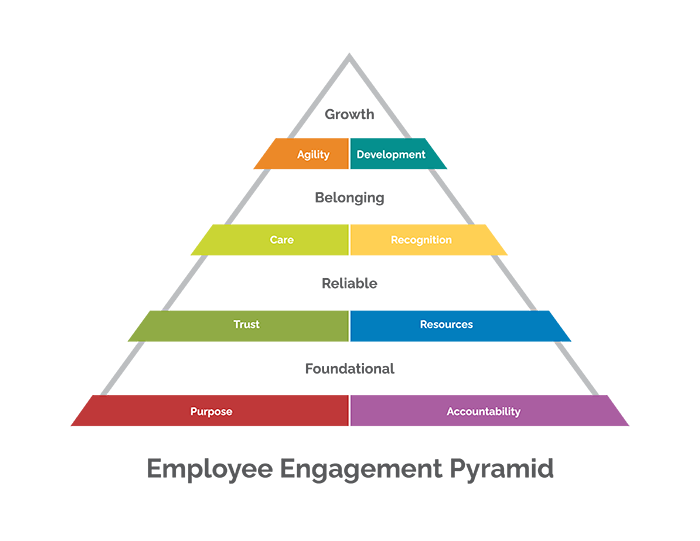 Next, focus on Trust and Resources: the Reliable Factor. Ensure employees can trust each other and that they can trust leaders to act consistently with what they say.
Next, focus on Trust and Resources: the Reliable Factor. Ensure employees can trust each other and that they can trust leaders to act consistently with what they say.
Provide the right resources to allow employees to do their jobs well.
The next level combines Care and Recognition to form a strong sense of Belonging – increasing loyalty and forging strong connections within the team to drive meaningful results.
Finally, optimize Agility and Development for Growth. Investing in individuals’ development leads to greater learning agility, or the ability to transfer knowledge from one situation to a new and different situation successfully. This is one of the greatest measures for high potential and allows the organization to become more resilient and agile in times of necessary change.
MEASURING EMPLOYEE ENGAGEMENT
Why you should measure employee engagement – even if you don’t think you have an engagement problem
 You’re likely juggling many priorities, including new challenges that have arisen recently in light of world events, so you might be wondering just how important employee engagement is. Can you keep it on the backburner a little longer? Does it really influence the bottom line? Is it really a consideration when you look at your team’s or organization’s employee turnover trends?
You’re likely juggling many priorities, including new challenges that have arisen recently in light of world events, so you might be wondering just how important employee engagement is. Can you keep it on the backburner a little longer? Does it really influence the bottom line? Is it really a consideration when you look at your team’s or organization’s employee turnover trends?
The short answer is: what gets measured gets managed gets done. Employee engagement, as a leading indicator, may help you identify the root cause of a resulting issue, enabling you to take action before it’s too late. If you measure it, problems become clear, and you can take immediate action.
What gets measured gets managed gets done.
EMPLOYEE ENGAGEMENT: HARNESSING THE POWER OF HUMAN POTENTIAL IN YOUR ORGANIZATION, Sicora Consulting
Employee engagement has never been more important to organizational success than it is now. As we’ve already discussed, employee engagement drives actual organizational results, meaning that putting off focusing on employee needs for too long could have noticeable negative effects on your organization. Further, employees are feeling more empowered and emboldened than ever to find meaning in their work. They want their work to align with their personal values, and they’re not afraid to leave a situation that’s a poor fit.
But what if you don’t have an employee engagement problem? The obvious first question is: how do you know? If you’re not measuring employee engagement, how can you be certain you’re maximizing on the potential of your workforce? The second question is: how will you know when employee engagement starts slipping? Do you really want to wait until there’s uncontrollable bleeding before tending to the wound? Consistently keeping an eye on your employee engagement can help catch potential issues quickly so you can address them before they grow.
How to Measure Employee Engagement
You might be convinced that it’s worth checking on employee engagement within your organization, but how? There are many employee engagement survey options, so which one is right for your organization?
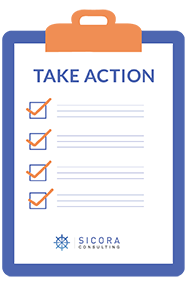 Most employee engagement surveys are conducted on an annual basis. The data is used as an annual benchmark against an industry standard and can easily be forgotten. Questions address most of the contributing factors to employee engagement, but many have gaps in what’s being measured, and most address lagging indicators that can’t be acted on. If an organization wants to make meaningful change to improve employee engagement, they must measure leading indicators – ones that can be influenced going forward.
Most employee engagement surveys are conducted on an annual basis. The data is used as an annual benchmark against an industry standard and can easily be forgotten. Questions address most of the contributing factors to employee engagement, but many have gaps in what’s being measured, and most address lagging indicators that can’t be acted on. If an organization wants to make meaningful change to improve employee engagement, they must measure leading indicators – ones that can be influenced going forward.
The 8 Factors of Engagement program addresses both the questions of how often to measure employee engagement and who takes responsibility for the results. The program includes an initial benchmark survey followed by regular quarterly “pulse” surveys. These short (typically about 3- to 5-minute) surveys produce immediate results and allow leaders to adjust quickly to employees’ needs in real time – without leading to survey fatigue. Additionally, employees are empowered to take action, so they’re not left waiting for their manager to do something. Pulsing employee engagement quarterly also emphasizes the strategic role it plays in an organization’s success, keeping it top-of-mind throughout the year.
Further, the 8 Factors of Engagement survey is designed to prevent false positives. Traditional employee engagement surveys can be “gamed” for higher scores. This can be exacerbated by programs that offer higher bonuses to managers whose scores come in higher. However, the true purpose of measuring employee engagement is to identify when something is broken so it can be addressed. Offering a regular quarterly survey about all leading factors that contribute to employee engagement promotes employee trust – they can believe the survey is looking for feedback so changes can be made if needed.
The true purpose of measuring employee engagement is to identify when something is broken so it can be addressed.
EMPLOYEE ENGAGEMENT: HARNESSING THE POWER OF HUMAN POTENTIAL IN YOUR ORGANIZATION, Sicora Consulting
One way to encourage employee trust when measuring engagement is to empower 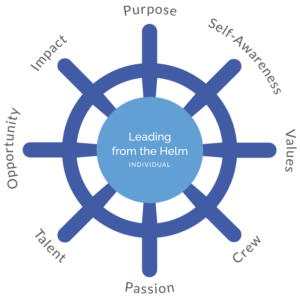 employees with the tools to take action and begin the dialogue around solutions. That’s why, beginning in early 2022, Sicora Consulting is offering employees their individual 8 Factors of Engagement profiles. While managers are largely responsible for employee engagement, they are only part of the equation. Individual employees can take an active role in their own engagement, as well as the engagement within their teams. As long as individuals have access to their own employee engagement data, they can identify where alignment is lacking and initiate the right conversations to make improvements.
employees with the tools to take action and begin the dialogue around solutions. That’s why, beginning in early 2022, Sicora Consulting is offering employees their individual 8 Factors of Engagement profiles. While managers are largely responsible for employee engagement, they are only part of the equation. Individual employees can take an active role in their own engagement, as well as the engagement within their teams. As long as individuals have access to their own employee engagement data, they can identify where alignment is lacking and initiate the right conversations to make improvements.
HOW TO INCREASE EMPLOYEE ENGAGEMENT
How to Improve Employee Engagement Scores
You know employee engagement matters, and you know how to measure it within your own organization. Now what? How can you take steps to improve employee engagement if it starts to waver?
First, it’s important to take a holistic, balanced approach. Consider everything that contributes to employee engagement and where your organization has weak spots. With that said, it’s important to start with a focus on the critical few. It could be overwhelming to tackle all eight factors at once. As long as you continue to make progress, you should start with the one or two things that are most important right now. Note: This isn’t necessarily the factor or factors with the lowest score. Use the engagement pyramid as your guide, and work from the bottom to build a strong foundation of employee engagement. Then work your way up.
Finally, consider what employees can take ownership of, what individual teams should tackle together, and where the organization and its leaders can support employee engagement efforts. While most employee engagement programs put the responsibility of engagement solely on managers, the individualized 8 Factors of Engagement profile provides employees with actions they can take to initiate improvements to help them feel more engaged and connected to the organization. Involving and empowering employees results in higher levels of commitment and quicker movement toward increased employee engagement. Meanwhile, the quarterly pulses will offer managers insights into how their team is doing as a whole. Employee engagement is not a task tackled in a vacuum. It’s up to everyone to work together to cultivate an employee-led culture of continuous engagement.
When to Start Your Employee Engagement Program
When should you start focusing on employee engagement? Now! You don’t need to wait for the new year, the new quarter, or even the new month. With a regular cadence of employee engagement tracking, you can take command with purpose at any time.
Download the Guide
Request your copy of EMPLOYEE ENGAGEMENT Harnessing the power of human potential in your organization by filling out this form.